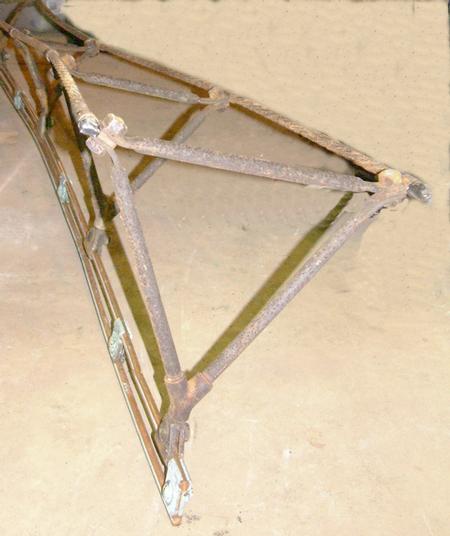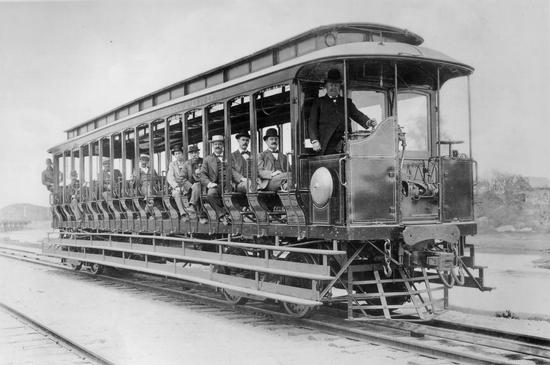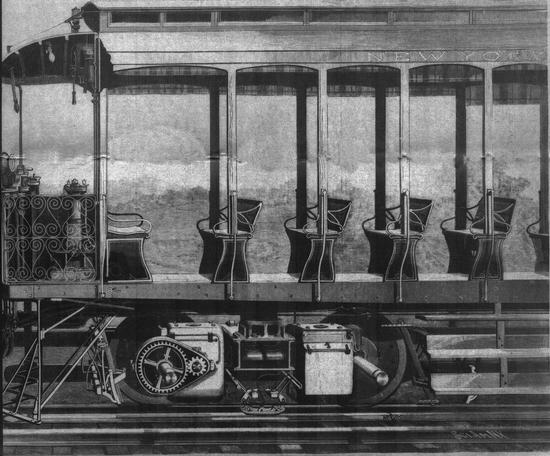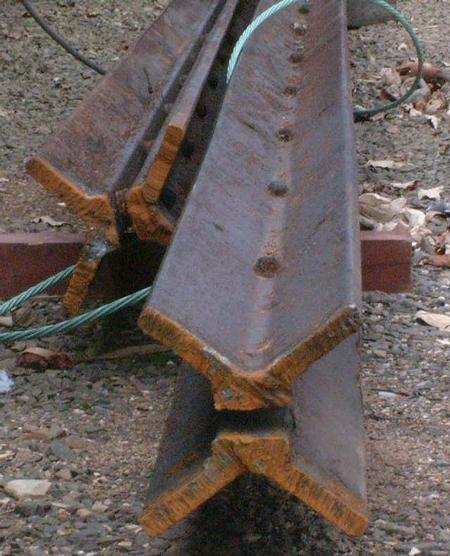
|
|
|
Museum Receives Third Rail
Do not be alarmed. The museum has no intention of installing third
rail to power its elevated and subway car collection. We did, however,
recently receive some rare artifacts pertaining to two forms of New Haven
Railroad electrification.
The New Haven's pioneering 11,000 volt, 25-cycle A.C. electrification
made headlines when it opened in 1907 from New York to Stamford.
The unusual triangular catenary with its oscillating cross-section
was a familiar sight along the right-of-way for ninety years. The
railroad, now Metro-North, is undertaking to replace all remaining
sections of this original catenary, which has difficulty in extremely
hot or cold weather. The New Haven R.R.
recognized this defect soon after opening and used a different
design on the extension
of electrification from Stamford to New Haven in 1914.
 |
| Section of original New Haven catenary. J. Hakner |
|
Jack Swanberg, a historian of the New Haven R.R. and a member of the
museum, arranged for the donation of a small segment of triangular
catenary to the museum. Mr. Swanberg's commentary on catenary
was featured in the Connecticut section of the Sunday
May 20th edition of the New York Times.
A decade before the high-voltage A.C. main line electrification, The New York,
New Haven and Hartford Railroad had several low-voltage D.C. electrified
lines featuring an unusual form of third rail. The railroad had a
branch along Nantasket Beach, about 20 miles outside of Boston,
with heavy summer riding. In 1895 the section from Nantasket Junction (where
the line diverged from the Old Colony main line) to the northern terminus
of the branch at Pemberton was electrified at 600 volts D.C. using trolley
wire construction. The opening on June 30th was, by a day, the
first electrification of a main line steam railroad (whereas lighter
trolley lines had been using this form of power for nearly a decade).
The railroad contracted with Colonel Nathan Heft, of the Bridgeport
Traction Company, to perform the work.
The cars in use on the Nantasket Beach line were heavy open cars, having
triple running boards, that pulled several trailers. They were equipped
with heavy GE2000 motors (135 hp each) and type L ``coffee grinder''
series-parallel controllers. Because of the heavy current drawn,
costs of the overhead transmission system were high.
 |
| Colonel Heft poses with railroad and General Electric officials at the controls of NY,NH&H RR open car 2510, during a trial of the 3rd rail in May 1895. President Charles Clark is behind him. General Electric photo, BERA Library, Charles Rufus Harte collection |
In 1896, the electrification was extended along the main line towards
Boston, from Nantasket Junction to Weymouth. This 3½ mile segment
was the first American use of third rail on a main line railroad.
The heavy third rail was better able to carry large currents than
the much thinner overhead wire. Unlike third rail to which the reader
may be accustomed, however, this installation placed the conductor rail
in the center, much like a Lionel train. The rail was supported by
blocks of wood which in turn rested on the ties. A gravity-type shoe
suspended from the truck slid along the top of the A-shaped rail.
This low-lying, exposed third rail was surely dangerous. At stations, the
third rail was discontinued. Overhead wire was provided to power the
cars in the station and to allow them to pull out.
In 1898-1899, third-rail electrification of the main line continued from
Weymouth to Braintree and on the southerly branch from Nantasket
Junction to Cohasset.
 |
| Illustration from Scientific American shows the mounting of the third rail pickup shoe from the truck. J.W. Swanberg collection |
Meanwhile, back in Connecticut, the main line from Hartford to New
Britain and onward to Berlin, as well as the New Britain to Bristol
branch, were electrified using the same A-shaped exposed third rail,
between 1897 and 1898. Equipment was similar to that in use on
the Nantasket Beach line, however, the third rail
was continued through the stations and the cars were not equipped
with poles.
Charles Mellen succeeded Charles Clark as president of the railroad in
1900. He did not share his predecessor's enthusiasm for D.C. electrification.
Third rail on the Nantasket Beach branch was removed in 1902 because
of technical difficulties. After the state legislature
passed a law in 1905 banning third rail unless it could be properly protected
(impossible with the center-running system), the railroad simply removed
the third rail on the Hartford-New Britain-Berlin-Bristol lines and reverted
to steam operation.
All of that fairly new third rail was not wasted, however. The New Haven
R.R. bolted lengths of it head-to-head, creating an X-shaped
structure known as an X-pole. These were used in various locations to
support lights and overhead wires. Recently, Metro North donated to
the museum a pair of these X-poles, thus finally bringing to a museum
artifacts whose brief but pioneering careers over a hundred years ago
might otherwise be lost to obscurity.
 |
| Two X-poles, each comprising two sections of A-shaped third rail bolted together, at the museum. J. Hakner |
Thanks to member Jack W. Swanberg who provided most of the data for
this article. Jack's book, New Haven Power 1838-1968, is a
comprehensive look at all forms of locomotion on said railroad.




